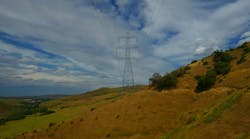A utility can determine moisture content for steady-state conditions using a family of curves that show moisture content in the paper as a function of relative oil saturation, with temperature as a parameter.
Along-standing principle for ensuring insulation reliability is to maintain a clean, non-contaminated environment within the insulating system. For insulated cable, manufacturers strive to produce insulations that are homogeneous and free of voids and foreign materials. For the insulation system within a transformer, it is important to provide oils that are free of moisture and gases. Traditionally, utilities have assessed the dryness of in-service transformers by taking periodic measurements of water content in the oil. By inference, the collected information can help estimate the moisture content in the insulating paper of the windings. Excessive moisture significantly reduces not only the dielectric strength, but also the partial discharge inception level. Moisture also effects the generation of gas bubbles at high temperatures, which creates a significant threat to the dielectric integrity of the insulation structure.
Moisture in Oil
The usual method for monitoring moisture has been to sample the oil at regular intervals as part of a scheduled maintenance routine. However, this procedure is problematic; since moisture content varies with the load, spot checks will rarely coincide with a worst-case scenario in which maximum water content will be measured. For example, in tests on a 10-MVA single-phase water-cooled transformer at a Hydro-Québec generating station, at full load, relative moisture saturation was measured with the Syprotec Aquaoil 33 monitoring device and found to be 83% at a temperature of 43°C (109°F). At no load, the relative saturation was 30% at a temperature of 35°C (95°F). Although this transformer can definitely be classified as “wet,” the measurements showing such large variations make it difficult to establish a true value for the water content in the insulating paper.
Several studies of the phenomenon carried out at GE Syprotec (Pointe-Claire, Québec, Canada) have shown the relationship between moisture in paper, moisture in oil and temperature. The critical factor is the relative moisture saturation at the oil/paper interface, which the utility can evaluate by simply calculating the winding temperature. One measurement technique, which can establish the relationship between temperature and the relative humidity of oil in contact with paper, uses GE Syprotec's Faraday Transformer Monitoring and Control System (TMCS). A single measurement of the relative saturation and temperature makes it possible to calculate the relative oil saturation at any temperature.
Moisture in Paper
The moisture in the paper wrapping of the windings is of interest, relative to the potential breakdown of the insulation medium. A utility can determine moisture content for steady-state conditions by using a family of curves that show moisture content in the paper as a function of relative oil saturation, with temperature as a parameter. Under steady-state conditions, so-called moisture partition curves determine the moisture in the paper based on the amount of moisture measured in the oil. Because these relations can be applied only when the transformer has been at a steady state for some time, the utility must use an approximation to estimate the amount of water in the main insulation.
Most of the water in the transformer is stored in the bulk insulation material, which constitutes the dielectric insulation between the windings. Equilibrium conditions between this insulation and the surrounding oil are difficult to achieve because of the long thermal time constant in these thick cellulose components. Fortunately, the insulation of greatest interest is the turn insulation within the windings, which is made of thin materials and is well irrigated by the oil. This insulation is the component that will be affected by thermal aging and is the site where gas may bubble under overload conditions. Therefore, it is acceptable that calculations of moisture in the paper be limited to the paper in the hottest part of the winding. Moreover, the utility should make this calculation only when the transformer is hot, since errors in estimating the moisture content at low temperatures are of little practical consequence.
Online Monitoring
The Faraday TMCS includes a moisture analysis model that continuously monitors the water-condensation temperature, the moisture content of the insulation paper and the bubbling inception temperatures. The model for the assessment of moisture content in winding insulation paper is based on the analysis of historical data in connection with the relative humidity in oil, the humidity sensor temperature, the top-oil temperature and the load current. The model is executed in a predetermined sequence (Fig. 1), in which the hot-spot temperature is computed from the oil temperature, load current and transformer characteristics. If the hot-spot temperature lies below 80°C (176°F), no further calculations are required, and the moisture content in the paper is assumed to be unchanged from the last calculated value. If the hot spot is equal to or above 80°C (176°F), the following parameters are averaged over the stability period:
- Average hot-spot temperature
- Average moisture content in oil
- Average sensor temperature.
These values provide the data to compute the relative humidity of the oil in contact with the winding insulation at the hot-spot temperature. Oil/paper partition curves are then applied to convert the relative humidity in oil to moisture content in solid insulation. In addition, the calculated value of the moisture content in the insulation is used to update a register where a default value is stored. This default value is used if the hot-spot temperature and thermal stability do not lend themselves to the application of equilibrium curves.
Conclusions
Using the GE Syprotec Aquaoil 300 relative humidity sensor, a utility can monitor the water content in transformer oil online. It then can use the collected data to determine the water-condensation temperature and relative humidity of the oil in contact with the winding insulation, which is inferred from the relative saturation characteristics.
To assess the moisture content of the solid insulation, the utility needs to make some compromises to deal with the difficult, dynamic pattern of moisture migration between the paper and oil. It is reasonable to focus on the thin winding insulation paper and disregard the bulk insulation that contains most of the water. Since the main concerns with moisture in paper are accelerated aging and the risk of bubbling, whose detrimental effects are to be feared only in the winding insulation at high temperatures, it is sufficient to limit the accurate assessment of moisture content to the condition of high hot-spot temperatures. Taking advantage of this simplification, the utility can apply online monitoring to identify quasi-steady hot-spot temperatures that allow for the assessment of moisture content in insulation paper at even the most critical operating conditions.
Acknowledgment
Acknowledgment is expressed to Jacques Aubin, a former research engineer at Hydro-Québec, for both his work on the development of advanced monitoring systems and in the preparation of this article. Aubin is presently on the staff of GE Syprotec.
Pierre Gravis is a senior chemist with the Transmission Apparatus Group at Hydro-Québec, which provides field support in diagnostic techniques for discovering faulty equipment and is responsible for the development of maintenance guidelines and monitoring policy. Except for the seven years he spent with IREQ, Gravis has been with the group since 1978 leading research work on liquid and solid insulating materials, studying condition monitoring, drying techniques and aging processes. Gravis received the MS degree from the University of Montreal in 1973.

